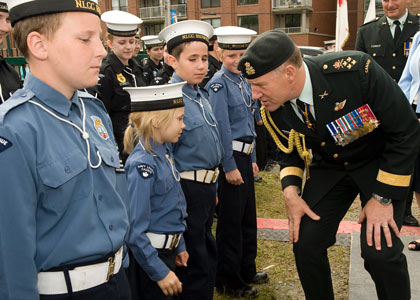 This information has been archived for reference or research purposes.
This information has been archived for reference or research purposes.
Archived Content
Information identified as archived on the Web is for reference, research or recordkeeping purposes. It has not been altered or updated after the date of archiving. Web pages that are archived on the Web are not subject to the Government of Canada Web Standards. As per the Communications Policy of the Government of Canada, you can request alternate formats on the "Contact Us" page.
Editor’s Corner

DND photo HS2009-0315-034 by Master Corporal Robin Mugridge
Always looking for fresh, young perspectives, the CDS, General Walt Natynczyk, consults a senior naval advisor during a visit to Halifax, 27 June 2009.
For more information on accessing this file, please visit our help page.
Welcome to the latest edition of the Canadian Military Journal, now officially, with 2010 appearing on the cover, firmly established in the second decade of our existence. As was briefly mentioned in the last issue, this year, Canada celebrates the 100th anniversary of the founding of the Canadian Navy, and, in tribute, all our 2010 issues will feature naval themes and the commemorative logo on the covers. Again, a very happy 100th birthday to all our sailors.
Discerning readers will note a slightly ‘leaner’ look to this particular issue. Unfortunately, the economic slowdown has affected us at the CMJ somewhat, in that new lowered thresholds for postal rates are forcing a modicum of size restraint for the time being. However, I pledge to use every trick in my editor’s book to minimize the concomitant impact of this fiscal restraint as much as possible.
Our lead article for this issue has been penned by a former Chief of the Land Staff, Lieutenant-General (ret’d) Mike Jeffery, and it constitutes a summary of his larger book-long case study on institutional leadership during Canadian Forces (CF) Transformation – Inside Canadian Forces Transformation: Institutional Leadership as a Catalyst for Change. General Jeffrey explores the transformation process, and how it was impacted by the leadership style of the then-Chief of the Defence Staff (CDS), General Rick Hillier.
Next up, Colonel Howard Coombs explores the paradigm shift that occurred in Canadian military thinking by virtue of the inclusion of the operational level of war ‘as an underpinning of professional military education’ at the Canadian Forces College (CFC) in 1987. Influenced in large part by its advocation in the United States Army and its adoption by the German and Soviet armies of the day, then championed by like-minded visionary officers at the CFC, Coombs maintains, “…[that] it showed how quickly the leadership of the Canadian military… was prepared to adopt a primarily American vision of organizing war…”
Professor Marc Imbeault, who teaches philosophy and leadership at the Royal Military College Saint-Jean, then examines Canadian participation in the war in Afghanistan, based upon the nation’s latest foreign policy statement, which reaffirms that Canada is committed to respecting fundamental human rights, and is prepared to fight for those rights when necessary. Further, Imbeault believes, “…[that] Canada’s engagement in Afghanistan is entirely logical, and it indicates a degree of coherence between the official discourse of the Canadian state and our country’s tangible actions in the world.”
Next, Major ‘Skip’ Fawcett, an Aerospace Controller, leads this issue’s Military History section with a review of the military and political imperatives that resulted in the creation of the North American Air Defence Command (NORAD), as it was originally called, in 1958. Fawcett concludes that sovereignty concerns were ultimately ‘trumped’ by military imperatives of the day, and that this enduring collaborative effort may well last for at least another 50 years. After all, were it to cease, who would track the Christmas Eve progress of Santa Claus?
Major Ray Stouffer then chronicles the uniformed and civilian career of Air Chief Marshal Frank Miller, Canada’s first Chief of the Defence Staff (CDS) and a former Deputy Minister of National Defence in the bargain. Stouffer argues convincingly that this remarkable leader, whose formidable contributions have been frequently overlooked and unappreciated in chronicling Cold War history, played a pivotal role in preparing Canada’s armed forces for the great changes wrought by its unification and integration during the 1960s.
Leadership issues remain an area of primary concern for the Canadian Forces. In this issue, we are honoured to publish some perspectives on striking a balance between leadership and life issues from a distinguished guest officer in our country, Colonel John Sims of the US Army.
In our Views and Opinions section, Captain Daniel Doran examines the role of the army reserve officer corps within the greater context of the Canadian Forces, highlights some of the more urgent challenges, and offers suggestions as to how these challenges can be addressed to “…assure reserve officer relevance within the current paradigm of operations.” Then, Captain Louis Hénault, an air navigator, reviews the operational impact of Operation Allied Force, the NATO air intervention in Kosovo in 1999, and how he believes that campaign has changed the application of airpower in future conflicts.
In this issue, our own stalwart Martin Shadwick takes a look at ‘Air Force Futures,’ specifically as studied recently by the Canadian Forces Aerospace Warfare Centre (CFAWC) with respect to such issues as “…futurecasting, concept development and experimentation, doctrine development, Air Force research and lessons learned.” The issue then concludes with a veritable treasure trove of book reviews, including a rare double review from different perspectives of a new title that many believe constitute a refreshing tribute and acknowledgement to a body of individuals often overlooked on the modern battlefield, the logisticians.
Until the next time.
David L. Bashow
Editor-in-Chief
Canadian Military Journal
![]()






